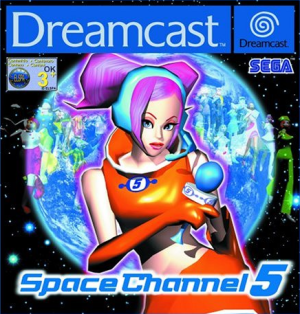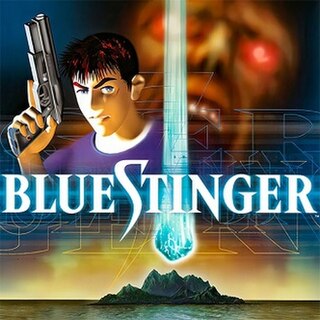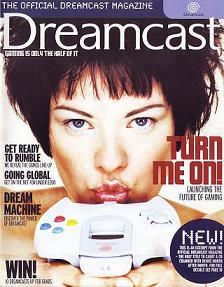
The Dreamcast is a home video game console released by Sega on November 27, 1998, in Japan; September 9, 1999, in North America; and October 14, 1999, in Europe. It was the first sixth-generation video game console, preceding Sony's PlayStation 2, Nintendo's GameCube, and Microsoft's Xbox. The Dreamcast was discontinued in 2001, ending Sega's 18 years in the console market.

Space Channel 5 is a music video game developed by Sega AM9 and published by Sega. Originally released for the Dreamcast, it was later ported to the PlayStation 2. A version for the Game Boy Advance (GBA) was published in 2003 as a Western exclusive. Following space-faring reporter Ulala as she investigates an alien invasion, players engage in rhythm-based combat where Ulala mimics the actions of rivals in time to musical tracks.

Phantasy Star Online is an online role-playing game (RPG) developed by Sonic Team and published by Sega in 2000 for the Dreamcast. It was the first online RPG for game consoles; players adventure with up to three others over the internet to complete quests, collect items and fight enemies in real-time action RPG combat. The story is unrelated to previous games in the Phantasy Star series.

Sega Net Link is an attachment for the Sega Saturn game console to provide Saturn users with internet access and access to email through their console. The unit was released in October 1996. The Sega Net Link fit into the Sega Saturn cartridge port and consisted of a 28.8 kbit/s modem, a custom chip to allow it to interface with the Saturn, and a browser developed by Planetweb, Inc. The unit sold for US$199, or US$400 bundled with a Sega Saturn. In 1997 Sega began selling the NetLink Bundle, which included the standard NetLink plus the compatible games Sega Rally Championship and Virtual On: Cyber Troopers NetLink Edition, for $99.

Blue Stinger is a 1999 action-adventure game developed by Climax Graphics for the Dreamcast. It was published by Sega in Japan, and by Activision in Western territories as a console launch title. The story follows emergency rescuer Eliot Ballade after he is stranded on the monster-infested Dinosaur Island and allies with fellow survivors and the alien being Nephilim to find the source of the monsters. Gameplay has Eliot navigating Dinosaur Island, fighting monsters using various weapons found or purchased during the game, and finding items to progress to other areas.
2001 saw many sequels and prequels in video games, such as Madden NFL 2002, NBA Live 2002, NBA 2K2, WWF Smackdown! Just Bring It, Capcom vs. SNK 2,Dead or Alive 3, Final Fantasy X, Gran Turismo 3: A-Spec, Grand Theft Auto III, Metal Gear Solid 2: Sons of Liberty, Myst III: Exile, Crazy Taxi 2, SSX Tricky, Super Smash Bros. Melee, Sonic Adventure 2, Tony Hawk's Pro Skater 3, and Virtua Fighter 4. New intellectual properties include Ace Attorney, Advance Wars,Animal Crossing, Burnout, Gothic, Black & White, Devil May Cry, Fatal Frame, Ghost Recon,Halo, Jak and Daxter, Max Payne, Oni, Onimusha: Warlords, Operation Flashpoint, Pikmin, Pro Evolution Soccer, Red Faction, Serious Sam, and Tropico.
1999 saw many sequels and prequels in video games, such as Chrono Cross, Dead or Alive 2, Donkey Kong 64, Final Fantasy VIII, Gran Turismo 2, Spyro 2: Ripto's Rage!, Heroes of Might and Magic III, Mario Party, Pokémon Gold/Silver, System Shock 2, Garou: Mark of the Wolves, Quake III: Arena,Resident Evil 3, Street Fighter III: 3rd Strike, Legacy of Kain: Soul Reaver, and Tomb Raider: The Last Revelation, along with new titles such as Tony Hawk's Pro Skater, Ape Escape, Shenmue, RollerCoaster Tycoon, EverQuest, Silent Hill, Syphon Filter, and Super Smash Bros..

Sega Rally 2 is an arcade racing game developed by Sega AM Annex for the Model 3 arcade hardware. It is the sequel to 1994's Sega Rally Championship. The game was first released in arcades in February 1998, and was later ported by Smilebit to the Sega Dreamcast, becoming one of the console's earliest titles when it was released in Japan on January 28, 1999. The Sega Dreamcast version was released in Europe as a launch title on October 14, 1999, and then in North America on November 27. A PC version was released in Japan and Europe that same year, with the North American release following suit in September 2000, where it was published by Mattel Interactive.

The Dreamcast is a home video game console by Sega, the first one introduced in the sixth generation of video game consoles. With the release of the Dreamcast in 1998 amid the dot-com bubble and mounting losses from the development and introduction of its new home console, Sega made a major gamble in attempting to take advantage of the growing public interest in the Internet by including online capabilities in the console as a selling point. As such, the Dreamcast was the first console to include a built-in modem for Internet support and online play. Sega would end up leaning heavily into the online capabilities to sell the Dreamcast as hype grew for Sony's then-upcoming competitor, the PlayStation 2, which also promised online gaming in addition to its DVD capabilities.

Hydro Thunder is an arcade inshore powerboat racing video game originally released by Midway Games in February 1999 and later released for the Sega Dreamcast as a launch title later that year. It was also released for the PlayStation and Nintendo 64 in early 2000. This game is part of Midway's Thunder series of racing games, which includes Offroad Thunder, 4 Wheel Thunder, and Arctic Thunder. Hydro Thunder Hurricane, a sequel to Hydro Thunder, was later released for the Xbox 360 on July 27, 2010 on Xbox Live Arcade.

Virtua Fighter 3 is the sequel to 1994's Virtua Fighter 2 and the third fighting game in the Virtua Fighter series, developed by Sega AM2 and published by Sega in 1996. It was the first arcade game to run on the Sega Model 3 system board.

Scud Race is an arcade racing video game released by Sega in 1996. It is the first racing game to use the Sega Model 3 hardware. Despite being released well within the lifetime of the Sega Saturn, no Saturn port was ever released. A Dreamcast port was announced for the system's 1998 launch lineup and was shown as a tech-demo in the Dreamcast Presentation in 1998, but was cancelled.

Official Dreamcast Magazine was a video game magazine published by Dennis Publishing in the United Kingdom between 1999 and 2001. The magazine held the license for the Sega Dreamcast console in the UK and featured a DreamOn demo disc on almost every cover. The magazine also featured complete games Sega Swirl and Planet Ring on its front cover. The magazine also covered fashion related to Dreamcast gaming but this feature was dropped in later issues.

Sega Power, initially known as S: The Sega Magazine, was a Future publication aimed at the Sega range of consoles, including the Master System, Mega Drive, Game Gear and later on the Mega-CD, 32X and Saturn. The magazine was later relaunched as Saturn Power when the other Sega consoles were discontinued.

Paragon Publishing Ltd was a magazine publisher in the UK, which published computer games and other entertainment titles from 1991 to 2003.

The PlayStation 2 (PS2) is a home video game console developed and marketed by Sony Interactive Entertainment. It was first released in Japan on 4 March 2000, in North America on 26 October 2000, in Europe on 24 November 2000, and in Australia on 30 November 2000. It is the successor to the PlayStation (console), as well as the second installment in the PlayStation brand of consoles. As a sixth-generation console, it competed with Nintendo's GameCube, Sega's Dreamcast, and Microsoft's Xbox. It is the best-selling video game console of all time, having sold over 155 million units worldwide, nearly triple the combined sales of the Dreamcast, GameCube, and Xbox.













